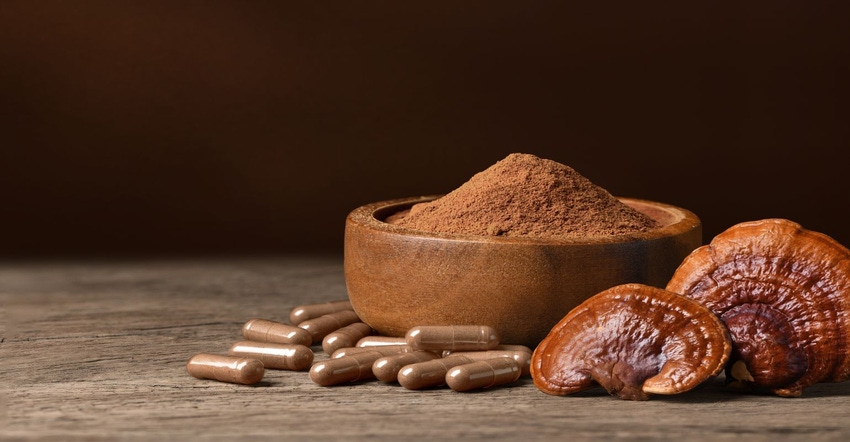Mushroom primer part II: Nammex on FDA petition, full spectrum products
In part II of this two-part Q&A column, Nammex Chief Strategy Officer Bill Chioffi discusses all things mushrooms.
August 9, 2023

Natural Products Insider: What does a “full spectrum mushroom product” mean?
Some claims made for fungal products, from the kingdom of fungi, regard “all stages,” or a “unique combination” of mushrooms and mycelium, or “full spectrum.” When making this claim, it’s essential to disclose a percentage of each fungal part. Because mushrooms are more expensive than MOG (mycelium on grain), they may be left out or included in small amounts just to make the claim of being present.
Generally speaking, “full spectrum” means the product in question has all the major components of the raw material present. So, an analysis of the product would show a profile that matches the data present in major published research or government databases.
For example, the U.S. Department of Agriculture has a database of foods and natural products that lists nutritional information based on approved analytical tests. If the product is a mushroom extract, full spectrum would indicate the naturally occurring components would remain in approximately the same ratio as the mushroom itself. Therefore, this designation would not be accurate to use for products that contain the grain inherent in MOG ingredients.
Natural Products Insider: What are the differences between a mushroom powder and an extract?
Although mushroom powders contain significantly more actives than MOG powders, they are still less potent than a concentrated extract. Practitioners of traditional Chinese medicine (TCM), who have used mushrooms and herbs for thousands of years, almost always make tea or decoctions from herbs and fungi. Teas and decoctions are simple water extracts. TCM practitioners will boil herbs for long periods of time to extract the medicinal compounds.
A hot water extract is a very simple and effective way to concentrate mushrooms and at the same time make them more bioavailable. The combined use of alcohol and water is utilized when some important compounds in the mushroom are not completely water soluble, such as Reishi or Chaga triterpenoids.
Mushroom cell walls contain chitin, which gives them their structure, and in the case of Reishi, make them hardened like the wood they came from. This chitin must be broken down in order to digest the materials like beta glucans contained in the chitinous cell walls. Water extraction performs this function quite effectively, and water ethanol extractions are employed when more thoroughly exhausting the triterpenoids and other alcohol solubles from the mushroom.
Natural Products Insider: How should fungus in dietary supplements be labeled based on federal requirements?
Plant parts are required disclosures on a Supplements Facts panel, in addition to disclosure of “other ingredients.” While FDA fails to specifically name fungi in this language, we can presume fungi is to be included in these regulations. The regulations pertaining to this matter can be found in 21 CFR 101.36(b)(3) and (b)(2)(i), 21 CFR 101.4(h), 21 CFR 101.36(d) and (d)(1), and 21 CFR 101.9.
FDA also has issued guidance, which defines the use and labeling of mycelium-based products in food.
“Mushroom mycelium grown in acceptable media is regarded as suitable for food use,” the FDA guidance states. “Any food in which mushroom mycelium is used should be labeled to state that fact. Labeling should not suggest or imply that the food contains mushrooms. For example, a soup in which mushroom mycelium is an ingredient should not be labeled or sold as ‘mushroom soup’ since that name by long consumer understanding and usage is preempted by soup containing real mushrooms.”
Even though the label may say “mushroom,” one should look at the Supplement Facts panel. For example, does it say Reishi mushroom, Reishi mushroom mycelium or Reishi mycelium? Some products will list the Latin name, Ganoderma lingzhi, without mentioning mushroom or mycelium.
Some companies will reveal if the product is mycelium. They will also state in the “Other Ingredients” portion of the Supplement Facts panel that there is grain or myceliated grain or “fermented [substrate source] biomass.”
While many mushroom products don’t fully disclose the fungal organism parts of their products or quantify the amounts of each in “full spectrum” products, we anticipate that to improve as more brands become aware of their regulatory obligations.
In 2017, the American Herbal Products Association (AHPA), through a collaborative group effort, produced a guidance document, “Labeling of Dietary Supplements Containing Fungi Dietary Ingredients.” The document, adopted in March 2017 and effective as of March 2019, is a helpful resource.
Since the effective date of AHPA’s initial efforts, initiated by Nammex, there have been positive changes. At least one company has moved this information out of the “other ingredients” area and inside the Supplements Facts panel since it constitutes a majority of the product and should be listed in that section by weight.
Natural Products Insider: Nammex recently submitted a citizen petition to FDA about labeling of mushroom products. What are you asking FDA to do?
We invested the time and expense of filing our citizen petition because the current FDA regulatory framework is inadequate to address the problem of mislabeling dietary supplements and foods containing fungi and fungal ingredients. With such rapid growth in demand for mushroom-derived products, we believe this problem must be addressed because consumers deserve accurate labeling.
We have made a compelling case for FDA to correct ambiguity in the regulation and make clear that the requirement to list the “part” of ingredients that are botanicals, along with the common or usual name, unambiguously applies to fungal ingredients. Industry guidance should make clear that although both “mycelium” and “mushroom” are derived from fungi, “mycelium” is not a “mushroom” or part of “mushroom.” We don’t put “plant root” on a label, we put “echinacea root.” So it’s misleading, and frankly nonsensical, to label something “mushroom mycelium” rather than “Reishi mycelium.”
Natural Products Insider: What are the current analytical methods that labs in the U.S. are using to assess mushroom quality?
The majority of medicinal mushrooms are known for their active polysaccharides, called beta-D-glucans. Some mushrooms like Reishi also have triterpenoid compounds and Cordyceps militaris contains the nucleoside, Cordycepin. It’s important that these compounds be listed and quantified. And it’s essential to ensure the claims are substantiated by actual testing documentation.
High polysaccharide numbers can be misleading. Polysaccharides can simply be starch, which is an alpha glucan and a major component of grain, which is commonly found in mycelium products.
Although beta glucan testing methods designed specifically for grains have been used to test mushrooms, the use of these grain-specific tests is not accurate for fungi. Neither are the commonly used tests to measure polysaccharides. The presence of starch (an alpha glucan and polysaccharide) in a mushroom product will artificially elevate quantitative test results for polysaccharides and give a false-positive for the medicinal value. For that reason, it is important to utilize a test method specific to mushroom beta glucans and that also separates the alpha glucans from the total.
In 2004, Megazyme International Ireland developed a test method specifically designed for beta glucans in mushrooms and yeast. The Megazyme method detects and quantifies soluble and insoluble beta-(1–3)(1–6)-glucans. Using this method, all stages of products in this category can be tested, including mushrooms, mushroom extracts, mycelia, sclerotia and even myceliated grain. Peer-reviewed in 2017 by the Journal of AOAC International, the Megazyme test is used by mushroom scientists worldwide.
The Megazyme beta glucan test also measures alpha glucan. The presence of starch in dietary supplements, especially as a carrier for extract products, is an ongoing industry issue. Grain products present a similar issue, since the grain is not separated from the mycelium. Testing for alpha glucans can determine the level of grain residue present in grain-based mycelium. It will also identify starch carriers used in mushroom extracts. Mushrooms contain only minor amounts of glycogen—on average, less than 3% by dry weight.
Ergosterol, the major fungal sterol, is a definitive marker compound that can also be used to assess the amount of fungal material in a given product. Ergosterol testing is used extensively by the grain industry to assess the presence of fungal contaminants in stored grain.
Ergothioneine is a sulfur-based amino acid. This substance has a specific transport mechanism, must be obtained from dietary sources, which include mushrooms as food with higher amounts than other sources, and has a direct transport mechanism into cells like other essential nutrients.
Ergothioneine is considered an intracellular antioxidant. The ergothioneine transporter controls and indicates ergothioneine activity. Since it is found in most medicinal mushroom species and there are HPLC methods available to analyze these compounds against pure standards, they have become part of analytical mushroom quality and characterization.
Other useful tests to perform are a standard nutritional starch test and a common proximate analysis for nutritional data, including mineral analysis.
Bill Chioffi is the chief strategy and innovation officer for Nammex, a manufacturer of certified organic medicinal mushroom extracts. Bill's 30 years of experience in the production and sale of botanical medicine encompasses retail, manufacturing, and food and beverage sectors. Bill worked for Gaia Herbs for 21 years, exiting the company as vice president of global sourcing and sustainability, and more recently as the vice president of strategic partnerships and business development for the Ric Scalzo Institute for Botanical Research at Sonoran University of Health Sciences. Current board positions include AHPA (American Herbal Products Association), United Plant Savers, and the Sustainable Herbs Program.
About the Author(s)
You May Also Like






.png?width=800&auto=webp&quality=80&disable=upscale)